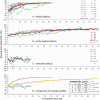The healing dynamics of non-healing wounds using cryo-preserved amniotic membrane
- PMID: 34791774
- PMCID: PMC9284646
- DOI: 10.1111/iwj.13719
The healing dynamics of non-healing wounds using cryo-preserved amniotic membrane
Abstract
We evaluated the effect of the application of cryo-preserved amniotic membrane on the healing of 26 non-healing wounds (18 patients) with varying aetiologies and baseline sizes (average of 15.4 cm2 ), which had resisted the standard of care treatment for 6 to 456 weeks (average 88.8 weeks). Based on their average general responses to the application of cryo-preserved AM, we could differentiate three wound groups. The first healed group was characterised by complete healing (100% wound closure, maximum treatment period 38 weeks) and represented 62% of treated wounds. The wound area reduction of at least 50% was reached for all wounds in this group within the first 10 weeks of treatment. Exactly 19% of the studied wounds responded partially to the treatment (partially healed group), reaching less than 25% of closure in the first 10 weeks and 90% at maximum for extended treatment period (up to 78 weeks). The remaining 19% of treated wounds did not show any reaction to the AM application (unhealed defects). The three groups have different profiles of wound area reduction, which can be used as a guideline in predicting the healing prognosis of non-healing wounds treated with a cryo-preserved amniotic membrane.
Keywords: cryo-preserved amniotic membrane; healing dynamics; non-healing wounds.
© 2021 The Authors. International Wound Journal published by Medicalhelplines.com Inc (3M) and John Wiley & Sons Ltd.
Conflict of interest statement
The authors declare no conflicts of interest.
Figures



References
-
- Moore Z. Why is EWMA interested in implementation?. (Oral presentation). 20th Conference of the European Wound Management Association, Geneva, 2010. Frederiksberg, Denmark: EWMA; 2010.
MeSH terms
Grants and funding
LinkOut - more resources
Full Text Sources

